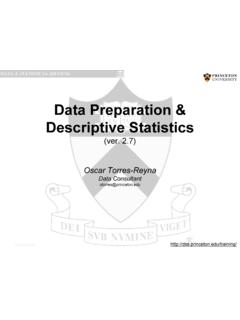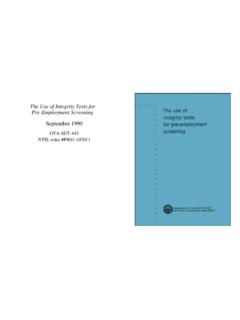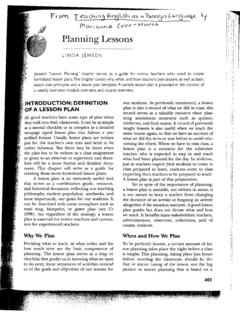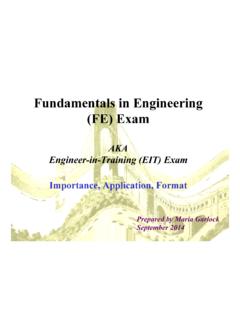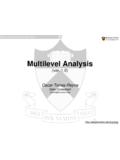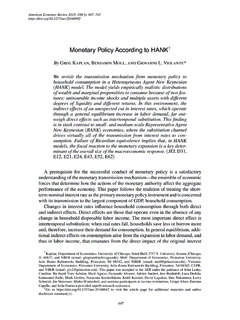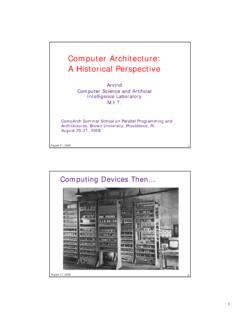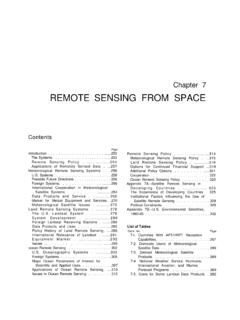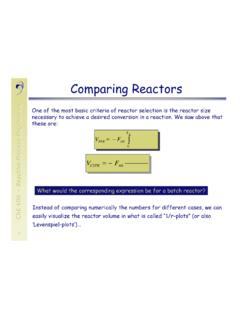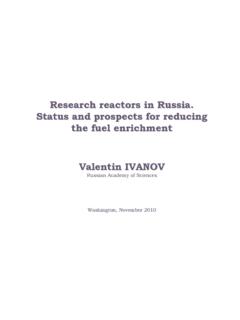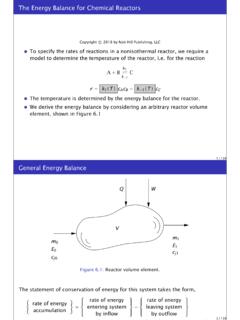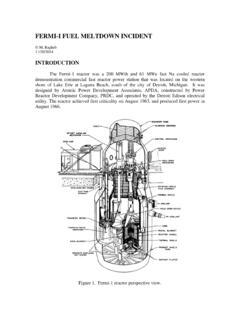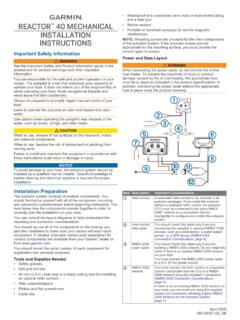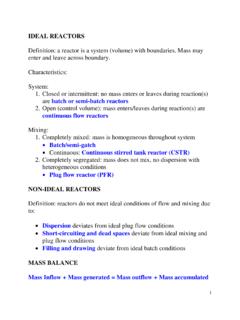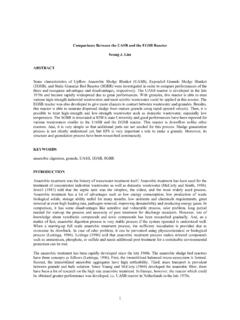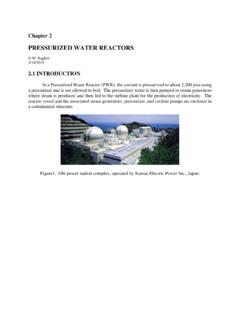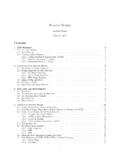Transcription of Fast Reactor Development in the United States
1 Science & Global Security, 17:109 131, 2009 CopyrightC Taylor & Francis Group, LLCISSN: 0892-9882 print / 1547-7800 onlineDOI: Reactor Development inthe United StatesThomas B. Cochran,1 Harold A. Feiveson,2and Frank von Hippel21 Nuclear Program, Natural Resources Defense Council, Washington, DC, USA2 Program on Science and Global Security, Woodrow Wilson School of Public andInternational Affairs, Princeton University, Princeton, NJ, USAThis article chronicles the rise and fall of fast- Reactor research in the United States . Re-search on fast reactors began at the end of World War II and represented a large fractionof the total research effort on civilian nuclear energy until the early 1980s. The goalof most of this research was to develop a plutonium breeder Reactor capable of producingmore plutonium from U-238 than is consumed. But with the termination of the ClinchRiver Breeder Reactor project in 1983, fast Reactor Development in the United Statesessentially ended. Safety issues played a role in this end to the fast breeder Reactor pro-gram, but more important reasons were nuclear proliferation concerns and a growingconviction that breeder reactors would not be needed or economically competitive withlight water reactors for decades, if HISTORYI mmediately after the bombing of Pearl Harbor on December 7, 1941, researchon plutonium production for atomic weapons was consolidated at the Univer-sity of Chicago under Nobel Laureate Arthur H.
2 Compton. The Metallurgi-cal Laboratory (later to become Argonne National Laboratory) was the codename given to Compton s facility. It was here that a small group of scientistsled by Enrico Fermi built the world s first Reactor ,Chicago Pile-1(CP-1), whichachieved initial criticality on December 2, 1942. During the next two years,work on the Development of plutonium production reactors shifted to OakRidge, Tennessee and then Hanford, Washington. By early 1944, Compton andthe Chicago scientists began thinking about the role of the Metallurgical Lab-oratory after the the morning of April 26, 1944, Enrico Fermi, Leo Szilard, EugeneWigner, Alvin Weinberg and others gathered to discuss the possibilities forReceived 1 October 2009; accepted 1 November correspondence to Harold A. Feiveson, Program on Science and Global Security,Woodrow Wilson School of Public and International Affairs, Princeton University, 221 Nassau Street, Princeton, NJ 08540. E-mail: et nuclear fission to heat and light scarcity of fissile materialwas on everyone s mind.
3 It was unclear at that time whether there was suf-ficient uranium even for producing highly enriched uranium and plutoniumfor a significant number of nuclear weapons. Fermi and his colleagues at theMetallurgical Laboratory therefore cast around for ways to produce maximumpower or plutonium for weapons with minimal recognizedthat some Reactor configurations might permit the conversion of uranium-238to fissile (chain-reacting) plutonium at a rate faster than the fissile uranium-235 was consumed, hence the term breeder Reactor . Walter Zinn, one of the nation s few Reactor experts and a close colleagueof Fermi, was soon recruited to the summer of 1944 he had beguna more detailed investigation of breeder Reactor designs. By the end of 1945,he had abandoned the idea of breeding uranium-233 in thorium and confirmedthe original plan of breeding plutonium-239 from uranium-238 using fast fis-sion 1945 Enrico Fermi said, The country which first develops abreeder Reactor will have a great competitive advantage in atomic energy.
4 6 The world s first fast-neutron Reactor wasClementine, a 25 kilowatt ther-mal (KWt), mercury cooled experimental Reactor built at Omega Site (TA-2) atLos was proposed and approved in 1945. High intensities of fission-spectrum neutrons were needed by the bomb designers. Also, operation of thereactor would supply information about fast reactors that would be relevant totheir possible use for production of power and fissile began in August 1946, criticality was achieved in late 1946,and full power in March 1949. It was fueled with plutonium metal with naturaluranium slugs at each end of the steel-clad rods. The rods were installed in asteel cage through which the liquid-mercury coolant flowed, driven by an elec-tromagnetic pump. The core was surrounded concentrically with a 15-cmthicknatural uranium reflector, a 15-cm-thick steel reflector and a 10-cm-thick shut down in March 1950 due to a control rod resumed in September 1952. It operated only until December 24,1952, however, when a fuel rod ruptured.
5 The uranium slugs swelled, burst thecladding and released plutonium into the mercury Reactor wassubsequently , Los Alamos developed and briefly operated one addi-tional fast Reactor ,LAMPRE-I. This sodium-cooled Reactor was fueled withmolten plutonium. It achieved initial criticality in early 1961 and operatedsuccessfully for several thousand hours until mid-1963. Designed to explore is-sues associated with using plutonium fuel in fast breeder reactors, it was origi-nally intended to operate at 20 megawatts thermal (MWt). It became apparent,however, that knowledge was inadequate about the behavior of some of thecore materials in a high-temperature, high-radiation de-sign power therefore was reduced to 1 MWt, with the plan to followLAMPRE-IFast Reactor Development in the United States111bya20 MWtLAMPRE-II. By mid-1963,LAMPRE-Ihad served its intendedpurpose and was shut down. Funding for the construction Hyman G. Rickover briefly experimented with fast-neutron reac-tors for naval submarine propulsion.
6 This effort began with General Electric sdevelopment and operation for the Navy of the land-basedS1 Gprototype at theKnolls Atomic Power Laboratory in West Milton, New York. TheS1G,whichwas HEU-fueled, operated from the spring of 1955 until it was shut downin 1957 after Admiral Rickover abandoned fast reactors for naval its brief operating history, the sodium-cooledS1 Gexperienced troublewith leaks in its steam was followed by the deployment of theS2 Gfast reactorin the nuclear submarine, USS Seawolf (SSN 575). According to Atomic EnergyCommission (AEC) historians, Hewlett and Duncan, in their history of the navy from 1946 to 1962:Although to complete her initial sea trials on reduced power in February1957, Rickover had already decided to abandon the sodium-cooled Reactor . Earlyin November 1956, he informed the Commission that he would take steps towardreplacing the Reactor in the Seawolf with a water-cooled plant similar to that inthe Nautilus. The leaks in the Seawolf steam plant were an important factor inthe decision but even more persuasive were the inherent limitations in sodium-cooled systems.
7 In Rickover s words they were expensive to build, complex to op-erate, susceptible to prolonged shutdown as a result of even minor malfunctions,and difficult and time-consuming to repair. 14 CONSOLIDATION OF BREEDER Reactor RESEARCH AT ARGONNENATIONAL LABORATORYIn 1946, the newly formed AEC took control of the nation s nuclear researchfacilities and tapped Zinn to head the Chicago laboratory, which by then hadbeen reorganized and renamed Argonne National Laboratory (ANL). The nextyear, the AEC Commissioners decided to consolidate the entire AEC reactorprogram at Commission needed reactors not only to produce plu-tonium for weapons but also for the production of radioisotopes and for generalresearch. There was also widespread public interest in using reactors to gen-erate electric drafting his section of the General Advisory Committee report, Zinnstressed power reactors. Here (as had been the case since 1944) a fact ofsupreme importance was the shortage of fissionable material.
8 Existing stocksof uranium ore seemed scarcely large enough to sustain production of a mod-est number of weapons, to say nothing of providing fuel for power plants. Zinn112 Cochran et the only hope for power reactors lay in those which would breed morefissile material than they convinced the AEC to give the breeder project a high priority andinsisted on directing the effort himself. Fermi promoted it by giving lecturesextolling the goal of extracting almost 100 percent of the fission energy fromnatural Breeder Reactor -IOn November 19, 1947, the AEC authorized ANL to design and builda liquid-metal-cooled, fast-neutron Reactor , the second fast Reactor in theUnited States ,Experimental Breeder Reactor -I (EBR-I), alternatively knownas Chicago Pile 4 and Zinn s Infernal Pile. TheEBR-Iteam decided to cool the Reactor core with a sodium-potassium(NaK) alloy. Since they knew little about the effect of this liquid-metal coolanton materials and worried that the control rods might stick or corrode, theydecided to cool them with air, which introduced the complexity of designingtwo completely separate cooling systems.
9 This was especially hard because thesodium-potassium metal will burn in both water and air. Therefore, there couldbe no fluid the beginning of the Manhattan Project, questions had been raisedabout the public safety concerns associated with building reactors in theChicago area. By summer 1948, Zinn was convinced the project needed to bebuilt at a remote site and asked the AEC to find Commissionerschose a site near Arco, Idaho, that had been a proving ground for navy ord-nance. It came to be known as the National Reactor Testing Station, now partof the Idaho National Laboratory (INL) and soon housed other ANL reactorprojects as well as other government the first fast-neutron Reactor designed to both breed plutoniumand to produce electric power. The MWt ( megawatt electric)22sodium-cooled Reactor went critical on December 20, 1951, and lit four 200-watt lightbulbs, thereby becoming the world s first electricity-generating nuclear powerplant. See Figure fueled with weapon-grade (94 percent enriched)uranium.
10 On June 4, 1953, the AEC announced thatEBR-Ihad become theworld s first Reactor to demonstrate the breeding of plutonium from the Reactor was designed with a prompt positive power coef-ficient of reactivity (increases in power had a positive feedback). On November29, 1955, during an experiment to obtain information about this instability,the Reactor had a partial (40 50 percent) core meltdown. The damaged corewas removed and the Reactor was repaired and operated until it shut down onDecember 30, accident atEBR-Ifocused attention on safety issues associated withliquid-sodium fast-neutron reactors and especially the possibility of an explo-sive criticality due to a partial melting and collapse of the core. This possibilityFast Reactor Development in the United States113 Figure 1:Experimental Breeder Reactor -I. By illuminating four light bulbs EBR-I became theworld s first electricity-generating nuclear power plant on Dec. 20, 1951. Source: ArgonneNational first studied by Bethe and 1983, the effective end to the Reactor commercialization program, analysts had concluded that theBethe-Tait analysis was overly conservative regarding the magnitude of thepotential energy release in a fast- Reactor accident, but that there were no uni-versally accepted estimates of upper limits on consequences of hypotheticalfast- Reactor accidents.
